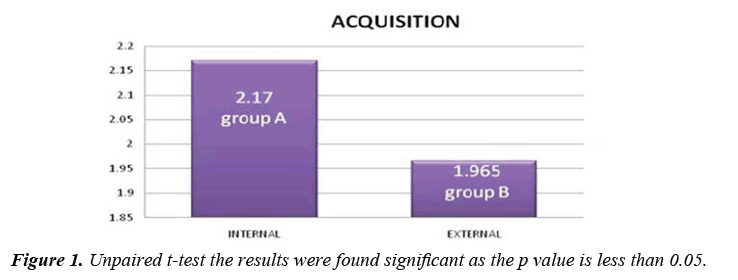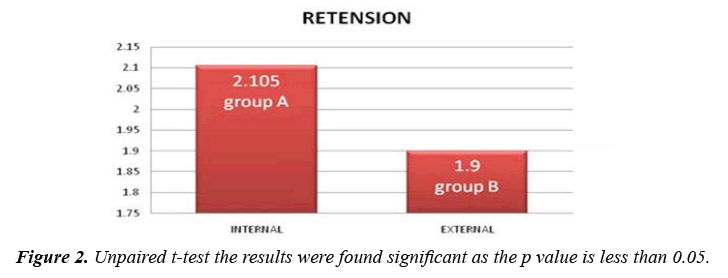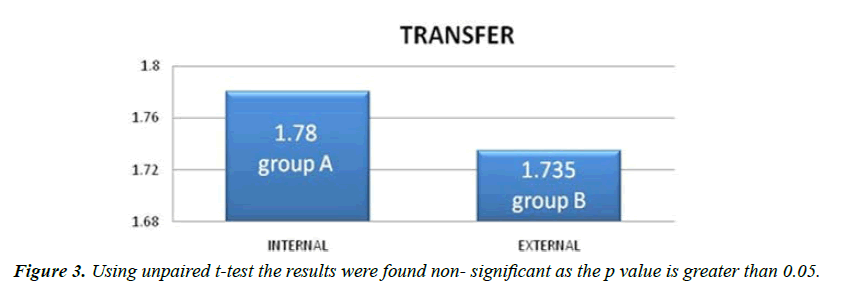Research Article - Journal of Physical Therapy and Sports Medicine (2023) Volume 7, Issue 1
Effect of focus of attention on motor skills acquisition, retention and transfer in children.
Shweta Pachpute*, Yogeshwari Sawant, Seema SainiDepartment of Physiotherapy, LSFPEFs College of Physiotherapy, Pune, India
- *Corresponding Author:
- Shweta Pachpute
Department of Physiotherapy
LSFPEFs College of Physiotherapy, Pune, India
E-mail: fernando.milan@uv.es
Received: 03-Jan-2023, Manuscript No. AAJPTSM-23-85741; Editor assigned: 05-Jan-2023, PreQC No. AAJPTSM -23-85741;(PQ); Reviewed: 18-Jan-2023, QC No AAJPTSM-23-85741; Revised: 20-Jan-2023, QC No AAJPTSM -23-85741; Published: 26-Jan-2023, DOI:10.35841/aajptsm-7.1.133
Citation: Pachpute S. Effect of focus of attention on motor skills acquisition, retention and transfer in children. J Phys Ther Sports Med. 2023;7(1):133
Abstract
Background: The focus of attention has been an on-going area of research in human movement science for the last decade. There is considerable evidence that directing attention externally to the effect of a movement on the environment (e.g., focusing on the flight of a ball in golf) improves performance compared to focusing internally on bodily movements involved in the execution of the motor skill (e.g., focusing on the motion of the arms in a golf swing). The advantage of an external focus of attention over an internal focus has been well documented across a wide variety of skills in adults but results are unclear in children .So the Aim of this study is to study the effect of focus of attention on motor skill Acquisition, Retention and Transfer in children.
Materials and Methods: 40 samples were selected. Subjects were randomly divided in 2 groups Throwing darts toward a static target was the motor skill. Instructions to direct their attention (internal/external) were given prior to the acquisition phase during which participants performed 50 trials. Retention and transfer trials were conducted 24 hours post acquisition phase.
Results: For acquisition and retention phases (unpaired t-test) the results were too significant (p<0.05). While for transfer phase (unpaired t-test) the results were non-significant (p>0.05).
Conclusion: Internal set of instructions was more beneficial in motor skill acquisition and retention phase in children. The study can be useful for the therapists, teachers who are dealing with the children.
Keywords
Internal focus, External focus, Acquisition, Physical therapists, Acquisition.
Introduction
Movement is critical aspect of life. Movement emerges from the interaction of 3 factors: The individual, the task, the environment. Motor control is the ability to regulate or direct the mechanisms to movement. The field of motor learning has traditionally referred to the study of the acquisition or modification of movement in normal subjects [1]. Learning has been described as the process of acquiring knowledge about the world. “Motor learning” refers to a set of internal processes associated with practice or experience leading to relatively permanent changes in motor behavior. The motor learning involves 3 main phases: Acquisition, retention and transfer. Acquisition refers to learning the motor task for the first time. Retention refers to performing the same task after a period of time and transfer refers to use this learnt knowledge and perform a similar motor task. “Attention focus is the act of directing attention to information sources or to objects of an individual’s attention [2]. Focusing the attention on the object or the effect of the action is known as “external focus” and on the movement or action itself is known as “internal focus”. Teaching of motor skill plays an important role in skill acquisition and it is a complicated process. Instructions are important when teaching motor skill and here physical therapists play a major part by teaching several new motor tasks to the clients or patients [3]. There are many studies suggesting that external focus is more beneficial in adults but results are unclear in children. Children are less exposed to the environment has a slower information processing as compared to the adults. Some can say that they have less motor experience. Therefore need of this study is to focus on the influence of instructions on acquiring motor skills and transfer in children. Aim of this study is to find out effect of focus of attention on motor skill acquisition, retention and transfer in children. Objectives are to study and compare the effects of external and internal of focus of attention on motor skill acquisition, retemtion and transfer in children [4,5].
Materials and Methods
Ethical committee clearance was obtained and permission was taken. Written consent was taken from the subjects who fulfilled the inclusion criteria. Sampling done by convenient sampling method.
Inclusion criteria
• Children in age group of 8-12 year.
• Children going to elementary school.
Exclusion criteria
• Children having developmental abnormalities.
•Children having musculoskeletal or neurological involvement.
• Children having eyesight problems.
• Children already knowing the motor skill or have knowledge about it.
Materials
Dart board, 10 standard soft tip plastic headed darts, measuring tape, chalks, assessment forms, pen.
Procedure
Ethical committee clearance will be obtained from concerned authorities. Once the subject fits into the inclusion criteria, intervention will explained and written consent will be taken on behalf of parents from the principle. A quiet room was selected to conduct the entire study [9, 10]. 40 Subjects were selected as per inclusion and exclusion criteria. They were randomly divided into 2 groups i.e., group A and group B. Group A was given internal set of instructions and group B was given external set of instructions. The motor skill was to throw darts on the centre of dart board which was placed at a height of 1.22 mts from ground and reference line was at 1.5 mts distance away from the dart board. Prior to the first phase, participants were explained and demonstrated the basic technique of throwing darts [11]. All the participants were given the same general instructions regarding the task goal and the throwing position. Instructions for the internal focus group were directed at the movements of shoulder, arm and fingers. Instructions for the external focus group were directed at the target, the darts, and the dart course [12].
Each participant came for 2 consecutive days (the entire study). On the first day, during the acquisition phase, participants threw 50 times in 5 trial blocks (10 throws per block). At the end of each trial block, the instructions were refreshed and the darts were removed. At the end of each block experimenter marked where the darts hit the board [13]. One day after the acquisition phase, both retention and transfer phases were conducted. In the retention phase, participants threw 20 darts (2 blocks of 10 throws each) from the same distance as in the acquisition phase. At the end of each block experimenter marked where the darts hit the board. Several minutes later, the transfer phase was conducted, in which participants threw 20 darts (2 blocks of 10 throws each) from a distance of 2 mts [14]. Again at the end of each block experimenter marked where the darts hit the board. No instructions were given in both retention and transfer phases. Data was collected and analysed. Points were distributed for each area of the dart board for easy statistical analysis (Table 1) [15].
| Area | Points |
|---|---|
| Central circle | 4 |
| Inner black circle 3 Outer red circle 2 Outside of board 1 |
Table 1. Points were distributed for each area of the dart board for easy statistical analysis.
Results
Paired t-test was done Results of p value for acquisition retention and transfer for internal focus found very significant (Figures 1-3 and Table 2-4) [16].
| Phase | Internal | External | P | Results |
|---|---|---|---|---|
| Acquisition | 2.17 | 1.965 | <0.05 | Significant |
Table 2. Internal set of instructions were more effective in motor skill acquisition.
| Phase | Internal | External | P | Results |
|---|---|---|---|---|
| Retension | 2.105 | 1.9 | <0.05 | Significant |
Table 3. Internal set of instructions were more effective in motor skill retention in this study.
| Phase | Internal | External | P | Results |
|---|---|---|---|---|
| Transfer | 1.78 | 1.735 | >0.05 | Non- significant |
Table 4. Internal and external set of instructions were equally effective in motor skill transfer in this study.
Discussion
Focused attention is the brain's ability to concentrate its attention on a target stimulus for any period of time. Focused attention is a type of attention that makes it possible to quickly detect relevant stimuli. We use focused attention, or mental focus, to attend to both internal stimuli and external stimulus and are an important skill that allows us to carefully and efficiently carry out tasks in our daily lives. Therefore the main goal of this study was to determine the effects of internal versus external attention focus on the performance and learning of children [17]. The attention is important for successful performance and learning. According to researchers, the poor performance of athlete is due to lack of enough focus and attention. In this study for effect of focus of attention on motor skill acquisition. Internal set of instructions were more effective in performing the task of dart throwing than external set of instructions. This can be due to the reason that the focus of attention depends upon skill. Similar to the findings of Wulf and colleagues, the highly skilled golfers performed better with external attention instructions than with internal focus instructions. In contrast, the low-skill golfers performed better with the internal than with the external focus of attention instructions [18].
The participants in this study may be more similar to low skilled adult players who have no experience with such activity. Therefore the internal attention instructions which were directed at the technique of holding and throwing dart resulted in better acquisition of the skill than external set of instructions. The study was significant for internal set of instructions were more effective in retaining the task of dart throwing than external. So the internal focus of attention is effective for motor skill retention in children. This can be due to the reason that the motor skill was acquired more by the participants who were given internal set of instructions therefore the retention was more. For Effect of focus of attention on motor skill transfer the study was insignificant for both sets of instructions. Therefore results are unclear. This can be due to the increase in target distance during the transfer phase required participants to invest more force, which served to decrease the accuracy of the throw. Previous studies showed that a change in the force factor usually worsened the throw accuracy among novice players. In addition, the change in throw distance caused participants to alter their pattern of movement and to make more mistakes.
Conclusion
Internal focus of instructions was found more beneficial in motor skill acquisition and retention the study can be useful for the therapists, teachers, sports coaches who deal with children of similar age groups. They may perhaps direct the attention internally for new motor skill acquisition and retention in children. In further scope of study can do it on large sample size, compare the study in girls and boys to see if gender differences exist, Long term retention can be tested, different age group within the children can be compared, and different methods of conveying instructions can be used to see the difference.
References
- Jarus T. Motor learning and occupational therapy: The organization of practice. Am J Occup Ther. 1994;48(9):810-6.
- Jarus T, Ratzon NZ. The implementation of motor learning principles in designing prevention programs at work. Work. 2005;24(2):171-82.
- Wulf G, Lauterbach B, Toole T. The learning advantages of an external focus of attention in golf. Res Q Exerc Sport. 1999;70(2):120-6.
- Wulf G, Prinz W. Directing attention to movement effects enhances learning: A review. Psychon Bull Rev. 2001;8(4):648-60.
- Shea CH, Wulf G. Enhancing motor learning through external-focus instructions and feedback. Human Movement Sci. 1999;18(4):553-71.
- Wulf G, Höß M, Prinz W. Instructions for motor learning: Differential effects of internal versus external focus of attention. J Mot Behav. 1998;30(2):169-79.
- Wulf G, McConnel N, Gärtner M, et al. Enhancing the learning of sport skills through external-focus feedback. J Mot Behav. 2002;34(2):171-82.
- Wulf G, Shea C, Park JH. Attention and motor performance: Preferences for and advantages of an external focus. Res Q Exerc Sport. 2001;72(4):335-44.
- Perkins-Ceccato N, Passmore SR, Lee TD. Effects of focus of attention depend on golfers' skill. J Sports Sci. 2003;21(8):593-600.
- Vance J, Wulf G, Töllner T, et al. EMG activity as a function of the performer's focus of attention. J Mot Behav. 2004;36(4):450-9.
- Cohen-Nachman S, Madkar A. The effect of learning strategies on learning new motor task among pre-school children. Israeli J Occup Ther. 2001;10:23-41.
- Hancock GR, Butler MS, Fischman MG. On the problem of two-dimensional error scores: Measures and analyses of accuracy, bias, and consistency. J Mot Behav. 1995;27(3):241-50.
- Beilock SL, Carr TH, MacMahon C, et al. When paying attention becomes counterproductive: impact of divided versus skill-focused attention on novice and experienced performance of sensorimotor skills. J Exp Psychol: App. 2002;8(1):6.
- Etnyre BR. Accuracy characteristics of throwing as a result of maximum force effort. Percept Mot Skills. 1998;86(3_suppl):1211-7.
- Cauraugh JH, Gabert TE, White JJ. Tennis serving velocity and accuracy. Perceptual and Motor Skills. 1990;70(3):719-22.
- Millar S, Al-Attar Z. External and body-centered frames of reference in spatial memory: evidence from touch. Percept Psychophys. 2004;66:51-9.
- Jani B, Rajkumar C. Ageing and vascular ageing. Postgrad Med J. 2006;82(968):357-62.
- Jarus T, Ratzon NZ. The implementation of motor learning principles in designing prevention programs at work. Work. 2005;24(2):171-82.
Indexed at, Google Scholar, Cross Ref
Indexed at, Google Scholar, Cross Ref
Indexed at, Google Scholar, Cross Ref
Indexed at, Google Scholar, Cross Ref
Indexed at, Google Scholar, Cross Ref
Indexed at, Google Scholar, Cross Ref
Indexed at, Google Scholar, Cross Ref
Indexed at, Google Scholar, Cross Ref
Indexed at, Google Scholar, Cross Ref
Indexed at, Google Scholar, Cross Ref
Indexed at, Google Scholar, Cross Ref
Indexed at, Google Scholar, Cross Ref
Indexed at, Google Scholar, Cross Ref


